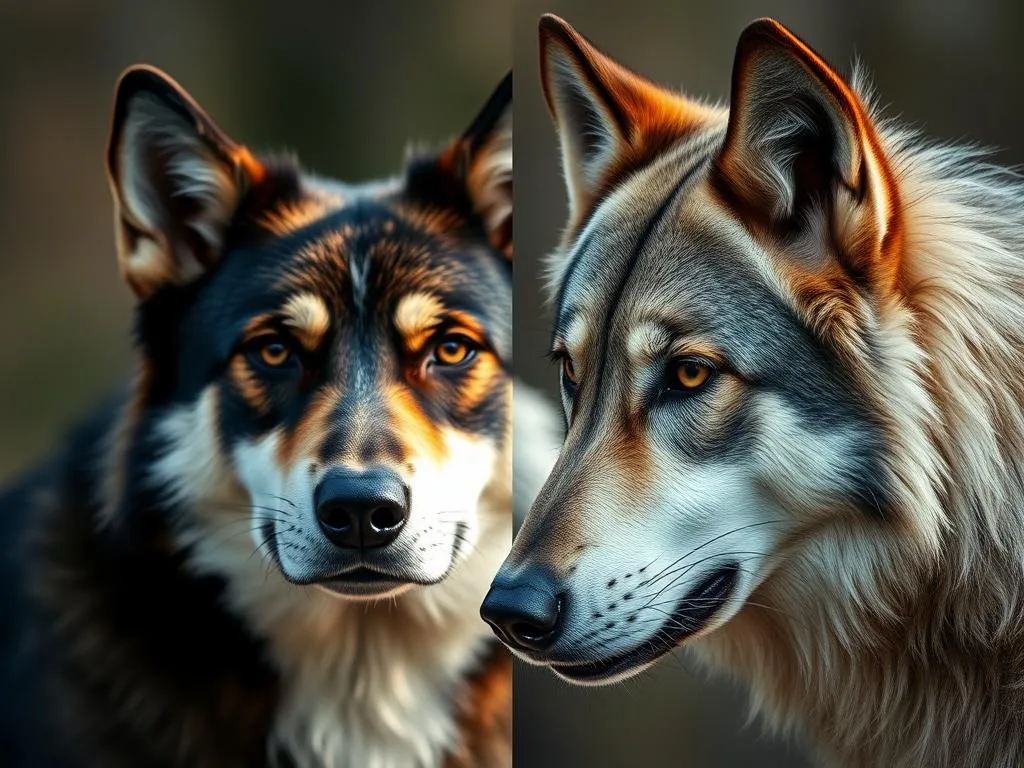
Introduction
Dog breeds have been a part of human culture for thousands of years, evolving from their wild ancestors into the diverse companions we know today. This journey of domestication has produced a wide array of breeds, each with unique characteristics tailored to various human needs. Understanding dog breeds is crucial for potential dog owners, trainers, and enthusiasts, as it helps in making informed decisions about breed selection, training approaches, and care requirements.
One fascinating aspect of dog breeds is their genetic relationship to wolves, their wild ancestors. This article will delve into the genetic connection between dogs and wolves, exploring which dog breeds are closest to wolves genetically. Understanding these connections not only satisfies our curiosity but also sheds light on behavioral traits and care needs of these breeds.
The Genetic Connection Between Dogs and Wolves
Evolutionary Background
The domestication of wolves into dogs is a remarkable story that began thousands of years ago. Researchers believe that ancient humans and wolves formed a mutualistic relationship, where wolves helped humans with hunting while receiving food and protection in return. Over generations, certain wolves adapted to living alongside humans, leading to the selective breeding of traits that favored tameness and sociability. This long process resulted in the diverse dog breeds we have today.
Genetic Similarities
At a genetic level, dogs and wolves share a remarkable amount of DNA. Studies show that domestic dogs (Canis lupus familiaris) and gray wolves (Canis lupus) have a genetic similarity of approximately 98.8%. This close genetic relationship is evident in various traits, from physical features to behavior. DNA testing has become a pivotal tool in revealing these connections, allowing researchers to track the lineage and genetic markers that differentiate breeds.
Current Understanding in Genetics
Recent studies have further illuminated the genetic ties between wolves and dogs, revealing that hybridization plays a role in some breeds. For instance, breeding between domestic dogs and wolves has created hybrids that display a blend of traits from both species. This ongoing research continues to uncover the complexities of canine genetics and the evolutionary pathways that have shaped our canine companions.
Dog Breeds Closest to Wolves Genetically
Criteria for Genetic Proximity
Determining which dog breeds are closest to wolves genetically involves analyzing specific genetic markers. Researchers examine mitochondrial DNA and nuclear DNA to identify shared ancestry. In addition, behavioral traits are considered crucial in understanding these genetic links, as many wolf-like breeds exhibit instinctual behaviors reminiscent of their wild ancestors.
Top Dog Breeds Closely Related to Wolves
Alaskan Malamute
The Alaskan Malamute is a powerful and resilient breed originally developed for sledding and heavy hauling in harsh Arctic conditions. They possess a thick double coat, erect ears, and a bushy tail, resembling their wolf ancestors. Known for their loyalty and affectionate nature, Malamutes are also strong-willed and require consistent training and socialization.
Siberian Husky
Another breed that is genetically closest to wolves is the Siberian Husky. Developed by the Chukchi people in Siberia, these dogs were bred for endurance and companionship. Huskies are known for their striking blue or multicolored eyes, thick fur, and playful demeanor. While they are friendly and sociable, they also have a strong prey drive and require ample exercise and mental stimulation.
Czechoslovakian Wolfdog
The Czechoslovakian Wolfdog is a unique breed that originated from a cross between German Shepherds and Carpathian wolves. This breed was initially created for military and working purposes. Czechoslovakian Wolfdogs exhibit a strong pack mentality and are known for their intelligence and loyalty. Their appearance closely resembles that of a wolf, and they require experienced owners who can handle their strong instincts.
Tamaskan Dog
The Tamaskan Dog is a relatively new breed that was developed to resemble wolves. This hybrid breed is derived from several wolf-like breeds, including the Alaskan Malamute, Siberian Husky, and German Shepherd. Tamaskans are known for their striking appearance, athletic build, and gentle temperament. They thrive in active households and require socialization and training from a young age.
Canadian Eskimo Dog
The Canadian Eskimo Dog is one of the oldest domestic dog breeds in North America, historically used by Inuit people for sledding and hunting. This breed is powerful, with a strong build and thick coat, making them well-suited for cold climates. Canadian Eskimo Dogs are intelligent, loyal, and have a strong work ethic, but they also require regular exercise and mental engagement to prevent boredom.
Behavioral Traits of Wolf-like Dog Breeds
Instinctual Behaviors
Many breeds that are closest to wolves genetically retain strong instinctual behaviors. For instance, these breeds often exhibit strong hunting instincts and a pack mentality, which is evident in their social interactions with humans and other animals. They may display behaviors such as howling, tracking scents, and forming close bonds with their families.
Training Considerations
Training wolf-like breeds can present unique challenges. Their independent nature and strong instincts might make traditional training methods less effective. Positive reinforcement techniques, patience, and consistency are essential when training these breeds. Early socialization is crucial to ensure they develop into well-adjusted companions.
Living with Wolf-like Breeds
Living with wolf-like breeds requires careful consideration of their needs. These dogs thrive in active environments where they can engage in physical exercise and mental stimulation. They may not be suitable for apartment living, as they often require space to roam and play. Additionally, their compatibility with families and other pets depends on early socialization and training.
Health Considerations for Dog Breeds Closest to Wolves
Common Health Issues
While many wolf-like breeds are generally healthy, they are prone to specific genetic predispositions. Common health issues may include hip dysplasia, eye conditions, and skin problems. Regular health screenings and a proactive approach to veterinary care are crucial for maintaining their well-being.
Nutritional Needs
Due to their high energy levels, wolf-like breeds require a balanced diet that meets their nutritional needs. High-quality dog food formulated for active breeds, rich in protein and essential nutrients, is recommended. Owners should also consider the specific dietary requirements of their breed and consult with a veterinarian for personalized advice.
Myths and Misconceptions About Wolf-like Dog Breeds
Myths About Behavior
There are several myths surrounding the behavior of wolf-like breeds, particularly regarding aggression. Many people mistakenly believe that these breeds are inherently dangerous or aggressive. In reality, a dog’s temperament is influenced by genetics, training, and socialization. With proper care and training, wolf-like breeds can be loving and loyal family companions.
Misunderstandings About Ownership
Owning a wolf-like breed comes with specific responsibilities and considerations. Some people may underestimate the legal requirements associated with owning these breeds, especially in regions where hybrid dogs are regulated. Additionally, potential owners should be aware of the time, effort, and commitment required to care for these intelligent and active breeds.
Conclusion
In summary, understanding the genetic connection between dogs and wolves enriches our appreciation of the diverse dog breeds we share our lives with. Breeds like the Alaskan Malamute, Siberian Husky, Czechoslovakian Wolfdog, Tamaskan Dog, and Canadian Eskimo Dog showcase traits that can be traced back to their wild ancestors. These breeds offer unique characteristics and require dedicated and responsible ownership to thrive.
As we explore the fascinating world of dog breeds, it’s essential for potential owners to conduct thorough research and consider their lifestyle and capacity to meet the needs of these remarkable animals. Wolf-like breeds, with their striking appearance and unique behaviors, require a deep understanding and commitment to ensure they are well integrated into the family environment.
FAQs
What dog is closest to wolf genetically?
The dog breeds closest to wolves genetically include the Alaskan Malamute, Siberian Husky, Czechoslovakian Wolfdog, Tamaskan Dog, and Canadian Eskimo Dog.
Are wolf-like dogs aggressive?
Not inherently. A dog’s temperament is influenced by genetics, training, and socialization. With proper care, wolf-like breeds can be friendly and well-adjusted companions.
What are the main health issues for wolf-like breeds?
Common health issues for wolf-like breeds include hip dysplasia, eye conditions, and skin problems. Regular veterinary care is essential.
Do wolf-like breeds require special diets?
Yes, wolf-like breeds typically require high-quality, protein-rich diets to support their energy levels and health.
Are there legal considerations for owning wolf-like breeds?
Yes, some regions have specific regulations regarding the ownership of hybrid breeds. It’s essential to research local laws before adopting a wolf-like dog.









